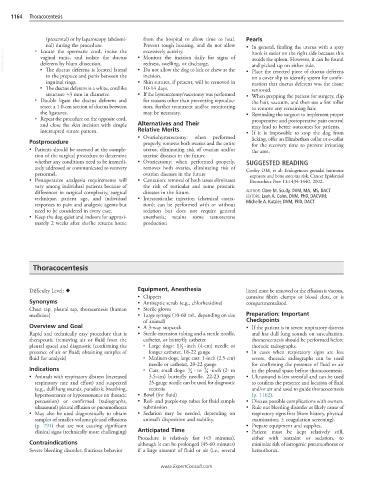Page 2352 - Cote clinical veterinary advisor dogs and cats 4th
P. 2352
1164 Thoracocentesis
(prescrotal) or by laparoscopy (abdomi- from the hospital to allow time to heal. Pearls
nal) during the procedure. Prevent rough housing, and do not allow • In general, finding the uterus with a spay
VetBooks.ir vaginal tunic, and isolate the ductus • Monitor the incision daily for signs of hook is easier on the right side because this
○ Locate the spermatic cord, incise the
excessively activity.
avoids the spleen. However, it can be found
deferens by blunt dissection.
redness, swelling, or discharge.
and picked up on either side.
The ductus deferens is located lateral
■
to the prepuce and penis between the • Do not allow the dog to lick or chew at the • Place the resected piece of ductus deferens
incision.
on a cover slip to identify sperm for confir-
inguinal rings. • Skin sutures, if present, will be removed in mation that ductus deferens was the tissue
The ductus deferens is a white, cordlike 10-14 days.
■ removed.
structure ≈3 mm in diameter. • If the hysterectomy/vasectomy was performed • When prepping the patient for surgery, clip
○ Double ligate the ductus deferens and for reasons other than preventing reproduc- the hair, vacuum, and then use a lint roller
resect a 1.0-cm section of ductus between tion, further treatment and/or monitoring to remove any remaining hair.
the ligatures. may be necessary. • Reminding the surgeon to implement proper
○ Repeat the procedure on the opposite cord, preoperative and postoperative pain control
and close the skin incision with simple Alternatives and Their may lead to better outcomes for patients.
interrupted suture pattern. Relative Merits • If it is impossible to stop the dog from
• Ovariohysterectomy: when performed licking, offer an Elizabethan collar or e-collar
Postprocedure properly, removes both ovaries and the entire for the recovery time to prevent irritating
• Patients should be assessed at the comple- uterus, eliminating risk of ovarian and/or the area.
tion of the surgical procedure to determine uterine diseases in the future
whether any conditions need to be immedi- • Ovariectomy: when performed properly, SUGGESTED READING
ately addressed or communicated to recovery removes both ovaries, eliminating risk of Cooley DM, et al: Endogenous gonadal hormone
personnel. ovarian diseases in the future exposure and bone sarcoma risk. Cancer Epidemiol
• Postoperative analgesia requirements will • Castration: removal of both testes eliminates Biomarkers Prev 11:1434-1440, 2002.
vary among individual patients because of the risk of testicular and some prostatic
differences in surgical complexity, surgical diseases in the future. AUTHOR: Clare M. Scully, DVM, MA, MS, DACT
technique, patient age, and individual • Intratesticular injection (chemical castra- EDITORS: Leah A. Cohn, DVM, PhD, DACVIM;
responses to pain and analgesic agents but tion): can be performed with or without Michelle A. Kutzler, DVM, PhD, DACT
need to be considered in every case. sedation but does not require general
• Keep the dog quiet and indoors for approxi- anesthesia; retains some testosterone
mately 2 weeks after she/he returns home production
Thoracocentesis
Equipment, Anesthesia
Difficulty Level: ♦ liters) must be removed or the effusion is viscous,
• Clippers contains fibrin clumps or blood clots, or is
Synonyms • Antiseptic scrub (e.g., chlorhexidine) compartmentalized.
Chest tap, pleural tap, thoracentesis (human • Sterile gloves
medicine) • Large syringe (10-60 mL, depending on size Preparation: Important
of animal) Checkpoints
Overview and Goal • A 3-way stopcock • If the patient is in severe respiratory distress
Rapid and technically easy procedure that is • Sterile extension tubing and a sterile needle, and has dull lung sounds on auscultation,
therapeutic (removing air or fluid from the catheter, or butterfly catheter thoracocentesis should be performed before
1
pleural space) and diagnostic (confirming the ○ Large dogs: 1 2 -inch (4-cm) needle or thoracic radiographs.
presence of air or fluid; obtaining samples of longer catheter, 18-22 gauge • In cases when respiratory signs are less
fluid for analysis) ○ Medium dogs, large cats: 1-inch (2.5-cm) severe, thoracic radiographs can be used
needle or catheter, 20-22 gauge for confirming the presence of fluid or air
Indications ○ Cats, small dogs: 3 4 - to 7 8 -inch (2- to in the pleural space before thoracocentesis.
• Animals with respiratory distress (increased 3.5-cm) butterfly needle, 22-23 gauge; • Ultrasound is less stressful and can be used
respiratory rate and effort) and suspected 25-gauge needle can be used for diagnostic to confirm the presence and location of fluid
(e.g., dull lung sounds, paradoxic breathing, centesis and/or air and used to guide thoracocentesis
hyperresonance or hyporesonance on thoracic • Bowl (for fluid) (p. 1102).
percussion) or confirmed (radiographs, • Red- and purple-top tubes for fluid sample • Discuss possible complications with owners.
ultrasound) pleural effusion or pneumothorax submission • Rule out bleeding disorder as likely cause of
• May also be used diagnostically to obtain • Sedation may be needed, depending on respiratory signs first (from history, physical
samples of smaller-volume pleural effusions animal’s disposition and stability. examination, ± coagulation screening).
(p. 791) that are not causing significant • Prepare equipment and supplies.
clinical signs (technically more challenging) Anticipated Time • Patient must be kept relatively still,
Procedure is relatively fast (<5 minutes), either with restraint or sedation, to
Contraindications although it can be prolonged (45-60 minutes) minimize risk of iatrogenic pneumothorax or
Severe bleeding disorder; fractious behavior if a large amount of fluid or air (i.e., several hemothorax.
www .ExpertConsult.com
www.ExpertConsult.com

